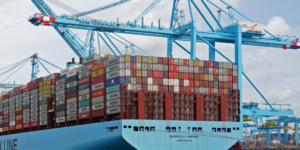
With shipping problems interrupting the supply chain around the world throughout the pandemic, people are looking for immediate solutions — moves that will impact the construction industry, which has already been hit hard by supply chain disruptions.
The Biden administration is looking to alleviate pressure on one key area in the system, announcing on October 13, 2021, that it would be working with the Ports of Los Angeles and Long Beach — points of entry for 40% of shipping containers in the US — to expand to 24/7 operation in an effort to speed up the international supply chain.
With the administration maintaining that “Moving goods during off-peak hours can help move goods out of ports faster,” the agreement additionally opened the door for companies like UPS, FedEx, and Home Depot to commit to increases in shipping movement, leading the White House to state “These commitments will speed up shipments of goods throughout the country.”
“Most of the products used to build the foundation and envelope of a house—wood, concrete, insulation, drywall, and shingles—are manufactured in North America, so the backup at the ports isn’t the problem for those goods,” said Webb Analytics President Craig Webb. “The big problem involves products manufactured entirely overseas, such as electrical and plumbing goods, as well as the small parts used in products like windows and doors.”
Webb noted that this was having a chain-reaction effect on the industry — and that contractors may be getting squeezed out more often than before.
“Manufacturers are limiting what they sell to distributors, distributors are limiting what they sell to dealers, and dealers (often for the first time) are limiting what they sell to customers,” he said. “One dealer in Montana told me had 1,000 electrical boxes in stock and a big customer wanted to buy 700 of them. The dealer had to say no, because if he sold that one customer all 700 then there wouldn’t be enough to serve all his other customers.”
Supply chain issues run deeper than just shipping delays
Even with a focus in the public and private sectors on how to alleviate this one aspect of the supply chain, industry officials are concerned that the situation is more multi-layered than it seems — which could make it much harder to recover from going forward.
Moody’s Analytics’ Tim Uy noted that “Supply will likely play catch up for some time, particularly as there are bottlenecks in every link of the supply chain—labor certainly, as mentioned above, but also containers, shipping, ports, trucks, railroads, air, and warehouses.”
“There are lots and lots of reasons why supplies aren’t getting through,” Webb agreed. “Foreign manufacturers are struggling with COVID. There aren’t enough cargo ships. There aren’t enough containers to put on those ships. The numbers of ships and containers we do have are enough to overwhelm the ports of Los Angeles and Long Beach. When the containers leave the port on trucks, there aren’t enough warehouses to hold the goods. When the containers are moved by train, there’s a huge traffic jam near Chicago. Truck drivers are at a premium. Warehouses can’t find people.”
“It’s a Gordian knot where everything is tied to everything else,” he added.
“Credit managers need to stay in close touch with their customers to help them manage through these delays.”
– Webb Analytics President, Craig Webb
What contractors and suppliers should know — and how they can navigate this period
Even though major players in the industry are working to alleviate the supply chain, contractors and other industry professionals may not see immediate benefits from smoother shipping — making it imperative that they keep an eye on cash flow.
“Projects are taking longer to complete. Consequently, cash flow is going to be strained,” Webb said. “Contractors and credit managers need to pay attention to cash on hand, and how long it’s going to take to get paid…Credit managers need to stay in close touch with their customers to help them manage through these delays.”

Thea Dudley teaches credit & collections
Join the free certificate course to learn the foundations of credit & collections in construction with 30-year industry veteran Thea Dudley.
Contractors need to keep an eye on how these delays are impacting their finances — managing cash flow is even more critical, as is maintaining prompt payment schedules on jobs.
“Our notions of just-in-time materials management are changing,” Webb continued. “You can’t be sure a product is in the store at the moment you need it. Thus, contractors and dealers will need to keep more goods in stock, just in case it’s not available at the store. That leads to price hikes and product runs, just as with the toilet paper shortages of a year ago.
Contractors may also have to look more closely at where their money is going, with Webb noting that “money spent for inventory [may not be] available for other things, like paying bills due.”
Even with world governments and private companies alike working to ease the situation, there’s a good chance the supply chain will continue to struggle for the foreseeable future, and that contractors may need to plan for a long recovery.
“As the global economic recovery continues to gather steam, what is increasingly apparent is how it will be stymied by supply-chain disruptions that are now showing up at every corner,” Uy said.
A lot is going to need to fall into place for recovery to go smoothly. “Inventory levels need to go back to historical averages,” Webb maintained. “People need to feel comfortable about how much they have in stock. We need more containers. We need more ships. We need people to work more smoothly. We need more truck drivers, more trains, more warehouses. All that takes time.”